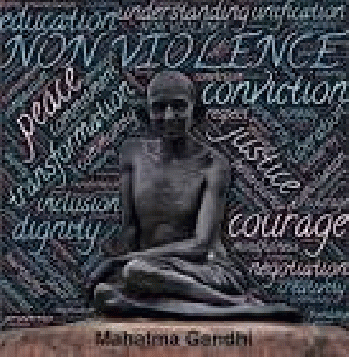
Free illustration: Non-Violence, Peace, Transformation - Free ...706 Ã-- 720 - 1305k - png
(Image by pixabay.com) Details DMCA
Background reading for the final week of the course included a lengthy segment from the book War No More: the Case for Abolition (2013), written by WBW's director, David Swanson. In his roles as anti-war activist, journalist, radio host, and prolific author, as well as a three-time Nobel Peace Prize nominee, Swanson has become one of the world's best-known anti-war advocates.
My purpose here is to summarize and comment on Part IV of Swanson's War No More: the Case for Abolition, which is headed "We Have To End War." This segment of the book offers a broad overview of World Beyond War's multifaceted, and continually developing, anti-war mission. In Swanson's words, that mission stands for something new: "not a movement to oppose particular wars or new offensive weapons, but a movement to eliminate war in its entirety." Doing that, he says, will require efforts of "education, organization, and activism, as well as structural [i.e. institutional] changes."
Swanson makes clear that these efforts will be long and hard, since they will involve converting deep-seated American cultural views from a broadly uncritical acceptance of wars authorized by the country's leaders, to a willingness to fight for the abolition of all war. He notes that America's military-industrial complex helps keep the public in thrall to "a permanent state of war in search of enemies." It does so through "the skills of propagandists, the corruption of our politics, and the perversion and impoverishment of our education, entertainment and civic-engagement systems." The same institutional complex, he says, also weakens the resilience of our culture by "making us less safe, draining our economy, stripping away our rights, degrading our environment, distributing our income ever upward, debasing our morality, and bestowing on the wealthiest nation on earth miserably low rankings in life-expectancy, liberty, and the ability to pursue happiness."
Despite the high mountain we need to climb, Swanson emphasizes that we have no alternative but to try to end war. Both war itself and the ongoing preparation for it are destroying the environment and diverting resources from a needed effort to preserve a habitable climate. Moreover, once wars begin, they are notoriously hard to control--and, given the availability of nuclear weapons that can fall into the wrong hands, that condition carries the risk of apocalypse.
Organizing and Education Are Priorities
To help sway public opinion from an acceptance of war to opposition, Swanson sees activist organizing and education as a priority. He points out that there is already much evidence such efforts can work. In 2013, for instance, activist rallies and demonstrations helped prevent a U.S. military assault on Syria following a gas attack, reportedly authorized by the Syrian government, on a rebel stronghold that killed many civilians. The demonstrations opposing war were supported by opinions expressed in public polling, within the military and government, and among elected officials.
In War No More: the Case for Abolition, Swanson references many activist and education initiatives that could help shift American cultural attitudes from an acceptance of war to opposition. Among them are creation of a Department of Peace to balance the existing so-called "Defense" department; closing prisons; development of independent media; student and cultural exchanges; and programs to counter false beliefs, racist thinking, xenophobia, and nationalism. Swanson insists, however, that, in doing these things, we must always keep our eyes on the ultimate prize. He states that "these efforts will only succeed in combination with a direct nonviolent assault on the acceptance of war."
Swanson also offers a number of recommendations for building a more effective war-abolition movement. We should bring into it, he says, all of the professional types--moralists, ethicists, psychologists, economists, environmentalists, etc.--who are, or should be, natural opponents of the military-industrial (or "military-industrial-government") complex. He notes too that some civil institutions--for example, the U.S. Conference of Mayors, which has pushed for a reduction in military spending, and labor unions that back converting war industries to peace industries--have already been allies in the anti-war cause. But he argues that such organizations must move beyond merely treating the symptoms of militarism to efforts to remove it by its roots.
Still another of Swanson's ideas for raising society's awareness that war can in fact be ended strikes me as especially creative. He encourages the building of true democratic governments at the local, state, and regional levels, in order to instill in the people directly impacted by them a sense of their own power to help create the social conditions that will play a role in shaping their lives. Though unexpressed, his obvious implication is that the awakening of this sense can carry over to similar expectations in matters of war and peace at the national and international levels.
Reaching Government Itself with the "End-To-War" Message
While I found compelling Swanson's ideas for turning public opinion and civil institutions away from an acceptance of war to opposition, I failed to find in the assigned classroom reading from his book an obviously important follow-up idea. That is a proposed strategy for bridging changed attitudes in civil society with efforts to achieve a similar result with the president and congress. It is with these pillars of government, of course, that the Constitutional authority rests to actually make decisions--though strongly influenced since Eisenhower by the military-industrial complex--regarding the scope of military preparedness and whether and how to go to war.
Based on what I learned in the online WBW course, a strategy that appears workable to me for expanding a movement aimed at a popular repudiation of war to also embrace government itself is essentially to pursue two purposes simultaneously: on the one hand, to try by every effective way known to free as many Americans as possible from an apathetic acceptance of war and militarism, making them instead committed supporters of war abolition; and, on the other hand, to team with any individuals and allied activist groups who share, or have come to share, this vision in a wide range of campaigns and actions designed to pressure the American government to take steps toward ending war as an institution of national security--perhaps beginning with nuclear disarmament. Such pressuring of government can in fact now be undertaken with the inspiration of mounting evidence that popular movements based on strategic non-violent resistance to government actions or policies believed to be unjust or irrational have a good chance of success. With the core support of as little as 3.5 percent of the population, such movements can in time grow to a point of critical mass and commitment at which the popular will can no longer be resisted.
On a less sanguine note, it should of course also be mentioned that it might well take years to build up the core support for an end-to-war movement to the critical mass needed to have even a chance to convince the American government to accept the outright abolition of war as a goal. And, at that point, as Swanson himself points out, it will take many more years to complete the process of verified global disarmament that is a necessary antecedent to any binding international agreement to end not only war-making but continual preparation for war.
(Note: You can view every article as one long page if you sign up as an Advocate Member, or higher).





